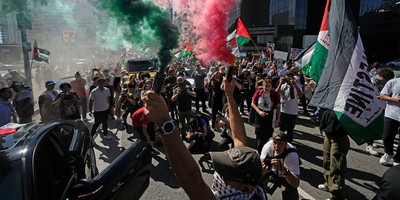Hope. Bloodshed. Perseverance. Change.
These powerful words provide a sketch of the Cold War, which in May 1989, when Hungary began opening the Austria-Hungarian border, entered a decisive phase marked by accelerating change.
Hope was crushed then imprisoned -- that was Eastern Europe's experience in the aftermath of World War II, as Russia's communists forged an iron curtain empire.
Revolts -- violent attempts to shed communist chains -- were smashed. In June 1953, Eastern Germans, demanding free elections, threw stones at Soviet tanks -- and were brutally suppressed. In late 1956, the Hungarians used rifles and anti-tank grenades.
The Hungarians fought alone, receiving no aid from a worried West, and suffered what NATO's secretary-general called "the collective suicide of a whole people." In 1968, the careful Czechs and Slovaks launched Prague Spring, an experiment in non-violent political liberalization with the goal of freedom. Prague Spring died in a cruel August of Soviet armor.
In 1984, the Orwellian year, former Hungarian Gen. Bela Kiraly told me at a Christmas party in Brooklyn, N.Y., that he was "now only an American professor." In 1956, Kiraly had served as military commander in Budapest. When the Red Army attacked the Hungarian revolutionaries, Kiraly's forces tried to resist, but they were completely overmatched militarily.
Kiraly and a remnant group of resistance fighters, pursued by two Soviet tank divisions, retreated toward the Austrian border. With a glass of holiday punch in his hand, he recalled giving his engineer officer orders to blow up an ammunition dump -- an attempt to buy his men more time to flee into Austria. The dump exploded, producing an unexpectedly large cloud. The tank divisions stopped, and Kiraly and his men escaped through the border wire. "I think the Russians thought the U.S. was intervening with nuclear weapons," Kiraly said.
Recommended
Of course, the United States wasn't. Avoiding all-out war in Europe, particularly nuclear war, was an American Cold War goal. With great perseverance, marred by a handful of dangerous lapses, the United States pursued "containment" of the Soviet Union, in hopes of achieving what George Kennan called (in his 1947 Foreign Affairs article "The Sources of Soviet Conduct") "either the break-up or the gradual mellowing of Soviet power."
In May 1989, I recalled Kiraly's desperate 1956 experience along the Hungarian-Austrain border when I read that Hungarian border guards had snipped the barbed wire dividing the two nations. Change? Within days, thousands of Eastern Europeans, the majority of the initial wave East Germans, began fleeing to Hungary, hoping to move on to freedom in the West.
By the end of the summer of 1989, that border was entirely open. On Nov. 9, 1989, the Berlin Wall cracked.
Definite change -- a grand and gratifying change.
But in May 1989, the outcome remained uncertain, as years of living on the thermonuclear brink tempered optimism. The next seven months produced a political and emotional rollercoaster, with bouts of elation followed by dread that the Russians would once again send tanks to close the borders.
The Russians didn't. The reasons are complex. A state-run economy inevitably produces shared poverty for all but the political elites. Russia had created a one-dimensional superpower, military might without economic muscle and cultural magnetism. The Kremlin had also suffered a stinging political defeat in 1983. In the late 1970s, the Soviets began deploying offensive SS-20 ballistic missiles in Eastern Europe. In response, NATO pursued a "dual track" strategy -- it would negotiate to remove the SS-20s but would deploy its own missiles if the Soviets refused.
By 1983, "dual-track" had failed. Despite tantrums by Moscow and the protest shenanigans of leftist sympathizers and Western "peace" organizations, Ronald Reagan deployed U.S. cruise and Pershing 2 ballistic missiles, militarily and politically countering the Russian threat. The "Euromissile Crisis" was a blatant attempt to crush Western European resolve and shatter NATO -- two blows that would have crushed Eastern Europeans' hope for freedom. In many respects, it was the last big political battle of the Cold War.
The United States is often knocked as shortsighted and irresolute, but U.S. Cold War policy was remarkably consistent and resolute. The Truman administration made several prescient strategic decisions (see NSC-68). The Eisenhower administration's refinement of "containment" (NSC-161/2) is a superb example of a new administration shouldering the burden of a long struggle. And in May 1989, that perseverance set the conditions for change.
























Join the conversation as a VIP Member